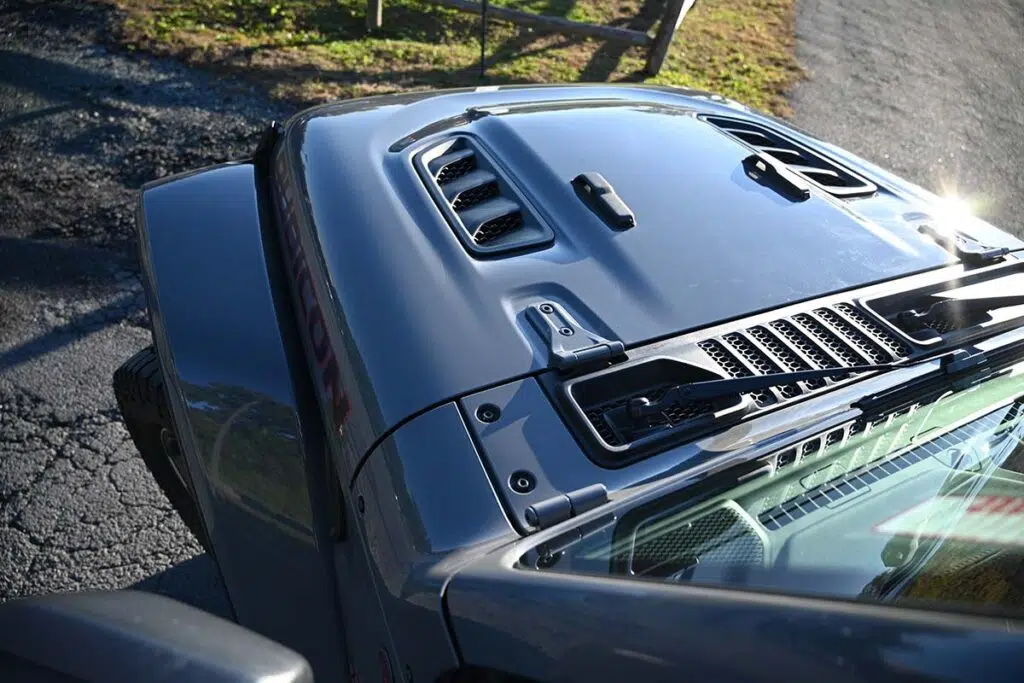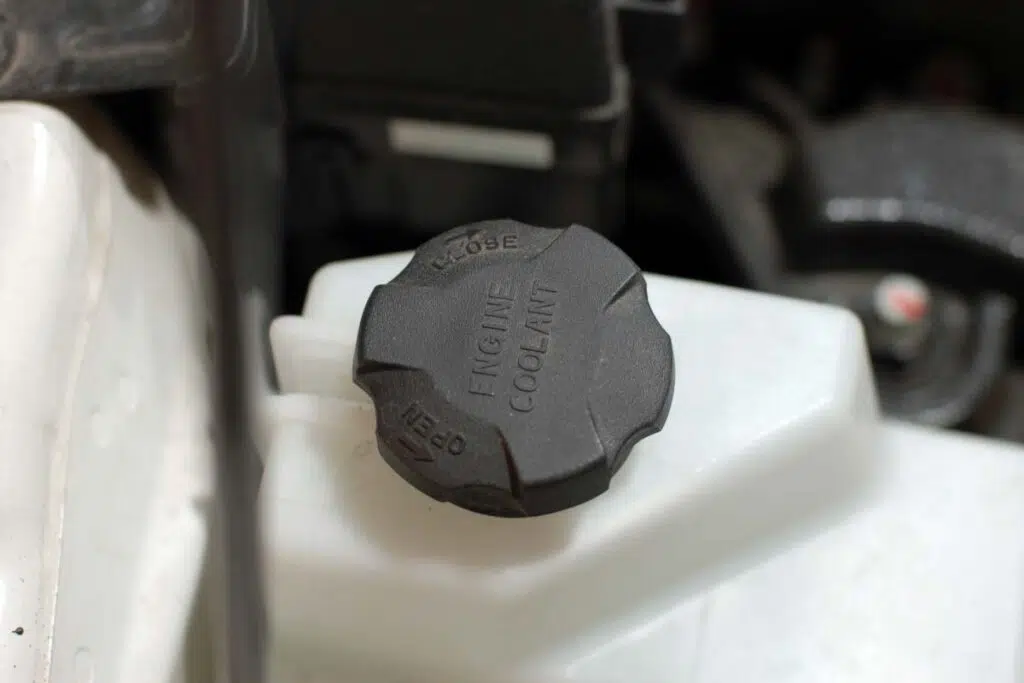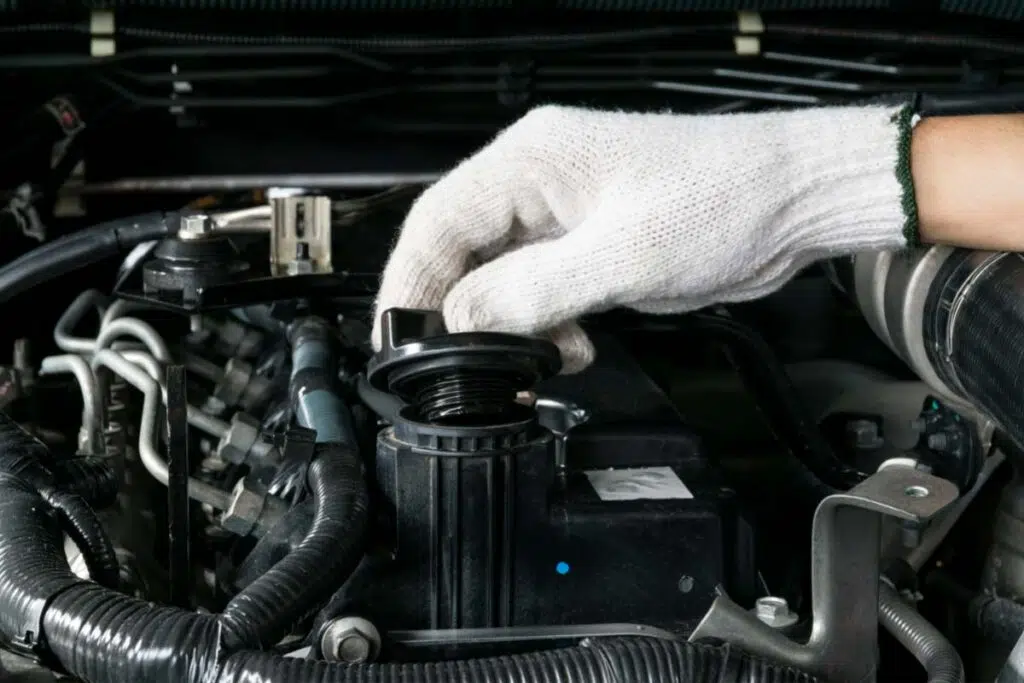Jeeps are known to safely operate at an engine temperature of 195° F. Slight variations in this temperature can be tolerated, especially if air conditioning is on or the vehicle has been idling for too long.
Anything above 200° F and your engine could overheat – in which case, you should stop and determine what is causing the spike in your engine temperature.
Among the most common causes of Jeep overheating are low coolant levels, clogged radiator fins, heater core issues, air pockets, and blown head gaskets. Some of these reasons are due to component wear and tear, while others result from poor vehicle upkeep and neglect.
To be more specific, below are twelve of the most common reasons behind Jeep overheating that you should be aware of:
- Insufficient or contaminated coolant
- Problematic water pump
- Faulty thermostat
- Clogged radiator fins, cooling tubes, or coolant hose
- Heater core problems
- Defective blower motor or resistor
- Bad fan or serpentine belt
- Airlock in the cooling system
- Stagnant antifreeze
- Turbulent or insufficient airflow
- Head gasket failure
- Low oil levels
Today’s article aims to familiarize you with the most apparent causes of Jeep overheating and give you top tips on diagnosing the issue. It also sheds light on factors we may not be aware can predispose the engine to overheat.
To avoid the hassle of having a busted engine while driving, stick around and continue reading this guide.
Why Is My Jeep Overheating?

1. Insufficient or Contaminated Coolant
Vehicle owners know how vital coolant is to keeping their Jeeps’ engines in optimal running condition.
This particular substance is responsible for keeping the cabin inside warm during cold days and the engine cool when the weather is hot. Hence, it should be no surprise that insufficient coolant levels result in the engine overheating or seizing up completely.
Two things immediately come to mind when drivers discover low coolant levels – either the coolant is leaking somewhere or refilling coolant levels as needed was missed (intentionally or otherwise).
But thanks to the below telltale signs, you no longer need to wait for the worst to happen before realizing that your coolant levels are below spec:
- Check Coolant message or light illuminates
- The overflow reservoir is empty
- The temperature gauge is fluctuating
- High-temperature gauge is in the red (or near it)
- The car heater is not working
- The air conditioning is acting up
- The coolant level sensor becomes faulty
- A sweet-smelling odor begins to permeate your cabin
The last item enumerated is a sure-fire indicator of a coolant leak. When you smell this scent inside your vehicle, check for external or internal leaks by inspecting the radiator, water pump, and EGR cooler (where applicable).
Remember to include faulty seals, damaged head gaskets, radiator hoses, and all relevant connectors between them. If you have identified an internal leak and are not too savvy in carrying out the needed repairs, seek professional help right away.
Do not forget coolant contamination, as it can also prevent your Jeep’s cooling system from performing effectively. Cracked cylinder heads and head gaskets – or any other damage to the cooling system and its components – are often the culprits behind coolant contamination.
2. Problematic Water Pump
Alongside low coolant levels, issues with the water pump are the top causes of Jeep overheating. The water pump is the cooling system component that controls the flow of coolant and water through the engine block and heater core – hence, it is important to keep it stable.
The part becomes unstable when internal erosion or contamination occurs and may stop working altogether. This occurrence leads to overheating and impaired engine function (or worse, severe engine damage).
3. Faulty Thermostat
Similar to the first two items, the thermostat is also dual-purpose. It stays closed when your engine is cold and opens up to allow coolant to flow to the radiator when the latter heats up.
Given the on-and-off nature of how it operates, a thermostat is subject to wear and tear and, therefore, warrants periodic replacement. However, not all stringently adhere to timely maintenance, causing the part to fail and manifest the below symptoms:
- High or inconsistent temperature readings
- Increased fuel consumption
- Poor engine performance
- Strange engine noises
Even if this condition were met, a thermostat could still fail due to age. And usually, older thermostats are prone to get stuck in the closed position. Once the thermostat gets stuck, the coolant no longer gets a chance to reach the radiator, which causes the engine to overheat rapidly.
Prolonged engine overheating eventually leads to more serious (if not potentially irreparable) engine damage.
A faulty thermostat (with coolant leaks and a malfunctioning radiator fan) is often the culprit behind a vehicle that overheats only when idle. It is likewise the top reason behind Jeep Grand Cherokee overheating. To avoid either scenario, replace your faulty thermostat as soon as you have discovered it.
Changing a thermostat is not difficult, provided you take precautionary measures and wait for the engine to cool down first before you give it a go. Remember not to re-use gaskets, and take care when scraping gasket residue off the component.
4. Clogged Radiator Fins, Cooling Tubes, or Coolant Hose
Since the radiator serves as your vehicle’s heat sink, it is important to keep it clog-free – along with the relevant tubes and hoses where coolant passes through. Because once these components become plugged, coolant would not be able to circulate, and engine overheating happens.
Also, inspect the fan blade and other parts for possible damage and check if the fans spin with the engine off. Pray that you would not have to replace the entire fan assembly unit (view on Amazon), as it can cost up to $800.
5. Heater Core Problems

A heater core could leak, translating to low coolant levels. Or it could have an obstruction that hinders coolant flow. By itself, a dysfunctional heater core is more likely to cause issues with keeping your vehicle toasty during winter.
But when combined with a defective water pump or plugged radiator, it may result in your Jeep overheating.
To prevent this occurrence, follow OEM-suggested intervals when changing the coolant in your vehicle – old or stale coolant becomes corrosive and may eat away at metal components inside the heater core. Additionally, look for the following:
- Corrosion or scale buildup
- Sludge resulting from coolant contamination
Stay away from using stop-leak products that may clog not only your heater core but also your radiator.
If you are getting rid of rust or are dealing with sediment buildup, a heater core flush would be the best solution. But if the procedure yields no results, you may need to replace the heater core, which costs up to $1,100 or more.
Luckily, a Genuine Mopar Heater Core (view on Amazon) can fit in some Jeep models.
6. Defective Blower Motor or Resistor
Although airflow restriction and damaged fan blades are mainly to blame for a faulty blower motor resistor, overheating causes the component to fail in some instances. It has a lot to do with the placement of the blower motor inside your Jeep’s HVAC system, making it heavily reliant on passing air to cool it down.
You would know it is your blower motor resistor causing your Jeep to overheat when you hear strange noises from the blower, smell burning, or feel no airflow from the air vents. Depending on the problem, you may need to do more than merely replace the blower motor to address engine overheating.
Change air filters regularly to minimize the likelihood of a defective blower motor resistor. Doing so reduces the formation of rust in the motor’s internal components, which hastens its deterioration.
All relevant components connecting to the blower motor should also be free of obstruction to ensure no restriction to airflow. Otherwise, getting a new blower motor would be futile.
While at it, inspect the fan belt (if your blower motor has one) and verify it is not snapped or jammed by a foreign object. Ensure the defect is not caused by a wiring issue or a bad capacitor.
7. Bad Fan or Serpentine Belt
The serpentine (or drive) belt is a component in the accessory drive belt system that provides power to the water pump (among other things) in some Jeeps. But due to the heat and friction it is subjected to when operating, it may not even last up to 50,000 miles or five years before it fails.
When it fails, the water pump (which controls water and coolant flow through the engine block) becomes compromised, resulting in Jeep overheating.
You should never tarry in resolving this problem the moment you identify it, as continued overheating can cause irreparable engine damage if left unaddressed.
It is advisable to do a regular visual inspection of the serpentine belt for any cracks, uneven rib wear, abrasions, and damaged ribs. Replace your drive belt if you spot any of these flaws.
8. Airlock in the Cooling System
Radiator airlock is a cause of Jeep overheating stemming from driving around with low coolant levels.
When coolant is inadequate, the water pump ends up pumping air into and causing airlocks or air pockets in the coolant system. The latter, in turn, hinders proper coolant circulation, which exacerbates engine overheating.
Another trigger of the airlock is the failure to maintain pressure. Since the cooling system is a closed, pressurized system, maintaining pressure is vital. However, things such as a loose radiator cap, blown head gasket, radiator hose leak, bad coolant refill, or improper flushing can trap air pockets inside the Jeep’s cooling system.
Per forums and other online sources, there is a way to prevent air from entering the cooling system during servicing or after a coolant flush.
Instead of installing the thermostat first, pre-fill it with coolant from the thermostat housing, install the t-stat, then top it off normally. Doing things in this order ensures air does not stay inside the cooling system, which temperature sensors may misconstrue as a hot engine.
9. Stagnant Antifreeze
Stuck antifreeze is known to disrupt the balance of your Jeep’s climate control system and engine temperature in two ways. It is more common to encounter issues with not getting warm enough inside the cabin.
However, antifreeze that becomes stagnant in the heater component can also speed up engine overheating, as it fails to reach the radiator to be cooled down. This issue does not happen by itself and often links to water pump (view on Amazon) or heater control valve issues.
10. Turbulent or Insufficient Airflow
Airflow is an afterthought for some Jeep owners, mainly when modding their 4x4s. As if turning their vehicles into monster trucks, many drivers run with bumper-mounted, gigantic spotlights, grille-mounted LED bar lights, aftermarket splash shields, and 30,000-lb capacity winches.
Yes, these add-ons add value to the Jeep’s off-roading capability. But if placed in the way of the radiator, they also restrict maximum airflow crucial to breathability and regulating coolant and engine temperatures.
By ensuring these accessories do not block off the front end, the radiator, transmission coolers (view on Amazon), and the A/C unit can perform optimally.
Restricted airflow also causes Jeep JK models, in particular, to overheat at highway speeds. When this happens, expect to see temperatures boiling over or on high.
You may also want to check if coolant was lost from the overflow reservoir or the radiator, as either will tell you if the reservoir was just over-serviced or needed further troubleshooting.
11. Head Gasket Failure
Most of the time, engine overheating is due to leaks or low coolant levels. But if you have ever asked yourself, “Why is my car overheating when the coolant is full?” chances are your Jeep might already have a blown gasket at the head.
An overfilled coolant reservoir is never the solution to keeping overheating at bay. Nor is a messed up coolant ratio.
Too much antifreeze causes the water pump to work doubly hard, while too much water overdilutes your coolant and prevents your engine block from cooling down when it should.
Interestingly, a blown head gasket is both a trigger and aftermath of engine overheating. While it is one of the causes of coolant leaks, it is also an outcome of purposefully driving with low coolant levels.
Head gasket failure is not a good symptom, as it is often a precedent to severe damage to the engine block. Not to mention that it is a clear sign of setting aside overheating problems for too long.
12. Low Oil Levels

Although not as frequently recurring as the other items in this list, insufficient oil is a definite cause of Jeep overheating. Engine oil possesses cooling properties that help control overall temperatures.
And when there is not enough motor oil in a vehicle, engine components tend to create more friction than usual, which adds to the production of heat.
How to Diagnose an Overheating Jeep
- Check fluid levels, including the oil and coolant, as they will give clues on what is causing your Jeep to overheat.
- Pressurize the system using a radiator cap tester – this procedure also helps confirm if you have an internal or external leak.
- Check the radiator hoses if they feel hard or full. If yes, do not open the radiator cap just yet, as its contents will be under pressure. Wait for the cap to be cool to the touch, and open it using a thick towel and safety goggles.
- Add engine coolant (as needed) until it is full, and start your engine. You are safe to drive if the temperature gauge does not go back up into the red. If it does, give your Jeep another 15 minutes to rest before starting it again.
- Clearing this last step is crucial to driving safely. If the temperature gauge keeps going into the red regardless of rest, you need to call towing services or a friend to help you with your vehicle.
Dos and Don’ts
Dos
- Stop driving immediately or as soon as it is safe.
- Roll the windows down if the ambient temperature is hot outside.
- Find a place to pull over and attempt a few easy fixes if your engine suddenly overheats while driving.
- Have the following tools handy:
- Emissions analyzer
- Power circuit probe
- Cooling system pressure tester (view on Amazon)
- Antifreeze funnel
- Diagnostic scan tools like Autel Scanner Maxicom MK908P 2022 (view on Amazon)
- Keep extra coolant and water in your car trunk and add these to your overheating engine (provided the cause is low coolant and the vehicle has cooled down for at least 30 minutes).
- Though seemingly counter-intuitive, turn off the A/C and put your heat on full blast to help shift the heat into the cabin and away from the engine.
- Do regular coolant flushes and exchanges to ensure no blockages in the passages or coolant contamination.
Don’ts
- Do not push your Jeep to the next service station if the engine overheats while on the road.
- Do not pop the hood immediately, lest you risk getting burn injuries from hot steam or smoke.
- Avoid pouring cold water into the hot radiator, as this sudden temperature change will do nothing but damage your radiator or cause temperature-induced damage.
- Even if it happens sporadically, do not leave the issue unattended.
Conclusion – Why Is My Jeep Overheating?
To recap, here are twelve common causes behind Jeep overheating:
- Insufficient or contaminated coolant
- Problematic water pump
- Faulty thermostat
- Clogged radiator fins, cooling tubes, or coolant hose
- Heater core problems
- Defective blower motor or resistor
- Bad fan or serpentine belt
- Airlock in the cooling system
- Stagnant antifreeze
- Turbulent or insufficient airflow
- Head gasket failure
- Low oil levels
This non-exhaustive guide aptly sums up the usual culprits behind engine overheating. While some of these factors result in restricted airflow or erratic temp gauge readings, others lead to complete dysfunction of individual cooling system components or severe engine damage.
Jeep owners like yourself should never disregard early signs of potential engine overheating. Being prompt in diagnosing and resolving them will help save you from costly repairs and more troublesome repercussions down the road.
But you do not have to take on these challenges on your own. If initial troubleshooting fails, do not be afraid to ask your local mechanic for assistance.
Kris is an avid off-roader and outdoor enthusiast who loves to brave the elements and take on challenging terrain. He also enjoys sharing his passion and knowledge with others so that they, too, can appreciate the ride.
About Kris
